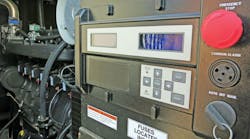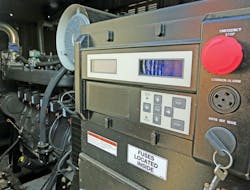Most of us have experienced a power outage at some point during our lives. Although it’s unquestionably inconvenient for homeowners to be without electricity, a power outage is far more than a simple annoyance for a health care facility, educational institution, or business that can’t afford even a minute of downtime. For organizations and institutions that can’t risk being without necessary power requirements, a reliable and properly sized backup generation system is essential.
“The goal behind backup generation is to make sure a facility is fully sustainable and redundant and that, no matter what happens on the electrical grid as far as voltage spikes, sags, and or brownouts, the facility won’t see it,” says Tracy McCulloch, senior project manager at Evergreen Power Systems in Seattle.
Role playing
In the world of backup generation, the role of the electrical contractor (EC) begins with the selection of a generator. “Unless contractors are working on a design-build basis, they’ll select a generator based on specifications provided by an engineer,” says Phil Arnold, project executive at Continental Electrical Construction Co. in Chicago. “After we get a specification that lists various generator manufacturers, we’ll get quotes from those companies and try to qualify proposals that meet the specifications. If several proposals meet the specifications, then we determine the lowest cost proposal that we have that meets the specifications.”
If an EC is working on a design/build or design/assist basis, the role can vary. In some cases, the EC, after getting the customer’s requirements, will design the engine’s size and the load. In other cases, the customer will ask that an electrical engineer and the EC work together on designing a system.
“Whatever the customer’s design criteria are for the generators to take control of the bus — N, N+1, or 2N — that would be what is dictated in the design, which is done by the electrical engineer and design-build electrical contractor and, in some cases, the company or manufacturer,” McCulloch says.
How much protection?
Backup generation systems vary depending on customer needs. Facilities for large computer-based companies, such as Amazon, telecommunications companies, and data centers want to see total redundancy — a complete generator backup all the way down to the server on the raised floor — so it will never experience an outage.
“All new servers nowadays have dual power sources or dual cords: an A + B or C + D or AB and CD sides,” McCulloch says. “Regardless of what side it is, every server has to have two sources: an A and a B power source, so if one server loses a power supply, the other power supply will keep it stabilized. You want to have it set up so power is from different distribution units all the way to the server.”
Keep in mind that there are also different tiers of backup. With what is called N power, a 2MW load would have 2MW of backup generation. That might sound sufficient, but if the backup generators fail, this would not be acceptable in many situations. N+1 would be the minimum backup configuration in a critical data center environment. With N+1, for a load of 2MW, there would be an infrastructure in place to provide 3MW. With 2N, there would be an infrastructure for 4MW, doubling the infrastructure for the load. “With N+1 or 2N, everything is redundant,” McCulloch says. “An A and a B side would each be loaded to 40%. If A fails, B takes control at 80%.”
Some customers may also use a UPS. Why? In hospitals and data centers, a UPS is used to carry the critical load for a short period of time where the power cannot be interrupted at all (i.e., operating rooms and critical servers in data centers). Once the generators are up and running, the UPS goes back to a normal state. Although the generators are sized to take control of most, if not all, of the facility load, the UPS is sized to only cover the critical load, which varies depending on each client’s needs.
Location, location, location
Commercial generator installation, another EC responsibility, starts from the ground up. One of the first steps is to determine where the generator will be located. Will it be placed indoors or outdoors? ECs installing generators placed outdoors must be aware of and meet the decibel (dB) code requirements of their municipalities in terms of sound attenuation — a requirement that is not imposed on indoor installations. For indoor installation, part of the process entails the floor’s design, which must be constructed using rebar to withstand the weight of a chosen generator. The EC provides the structural engineers with the generator’s weight and how much load they’re putting on any particular slab, and the engineers do the structural calculations to design it to carry the load.
Prior to transporting a generator to a site, it undergoes a factory commissioning process. The EC and client will frequently engage in witness testing per the specifications and stress test the equipment prior to shipment. Handling the generator system installation on-site typically involves collaborating with multiple trades and contractors. For example, after the EC solicits pricing from manufacturers and machinery moving/rigging companies, a crane company must be selected. Working under the direction of the riggers, the EC will place a generator onto tank rollers that are powered to move the generator to its destination. The moving company then secures it, pulls out the rollers, and drops it on the deck.
“While an install is proceeding, we’ll have one person there to make sure any conduits that are installed are in the right location and don’t get damaged as the machine is put in place,” says Arnold. “Then we put in a crew of electricians to do the wiring, which varies depending on the manufacturer and location. Is it on a steel structure or the ground or the roof? There are so many variables, and our crew will work with the mechanical [contractor] either as a blended crew as they do fuel systems, cooling and exhaust, or the two crews will work separately.”
The generator is then tested again. “Once installation is complete, we then go through a second commissioning process at the site doing load-stepping, which involves progressively adding load,” explains McCulloch. “For a 2MW engine, we would add 500kW, then 1,000kW, then 1,500kW, and then 2MW. We’d burn in for 8 hours to make sure it can handle the whole load in a sustained outage. The last test is across-the-line full load, meaning we put a full 2MW on the engine to see how it reacts.”
Powering up
ECs also have to be aware of issues related to the fuel sources. In larger facilities, diesel engines usually provide generator power, while gasoline-fueled generators are used in some smaller buildings. One issue of fuel source relates to storage. “You have facilities that hold as much as 120,000 gallons of No. 2 diesel fuel,” McCulloch notes. “In one facility where we did the installation, the fuel was stored underground. When needed, it fed to day tanks that fed 2MW engines that burn about 150 gallons per engine per hour.”
ECs also need to determine the burn rate (i.e., how quickly the fuel burns) to determine the amount needed for any given time. “Burn rate is based on kilowatts,” says McCulloch. “For example, 100kW of load per engine uses about 7.5 gallons of fuel, which means that for a 2MW load to be fully loaded, 266 gallons of fuel would be needed. But we would never fully load them. Forty to 45% is as much as we’d load it. So if you have 4.5MW of load and 8MW of engines, all those engines will take about 1.2MW, which means they will not burn the whole 266 gallons per hour but perhaps approximately 150 gallons. ”
According to McCulloch, they will burn less because it’s based on 100kW of load per engine. “Since they are paralleling, they are sharing the total load and burning less fuel,” he says.
Putting it to the test
In the event of an outage, the client will get to experience the fruit of your labor when the backup generators kick into gear. “If the grid starts getting really unstable, whether in an outage or a spike or multiple sags or spikes — and if it persists for a period of time — the client can elect to go to engines until the storm and/or unstable grid stabilizes or let it happen automatically,” McCulloch says. “When we talk about the generator getting to the bus, it means that the generator’s engines electrically start up, the control system synchronizes them to the utility paralleling board, and the transfer starts.”
He goes on to note that during this process, the UPS holds the critical load stable while other systems in the building (i.e., mechanical) can sustain a momentary outage until the generators have control of the facility, then auto-restart once power is available.
“For example, at one large telecommunications facility we worked on, there were approximately 1,200 to 1,400 control connections,” McCulloch says. “Automation needed to make sure that the paralleling switchgear was looking at the utility bus, generator bus and transferring to either source automatically.”
With a stand-alone generator, when the utility source fails, an automatic transfer switch (ATS) sends a start signal to the generator to start. Once it is at rpm and reaches the rated voltage, the ATS sends another signal to indicate to transfer to the emergency source.
“Redundant capacity to serve the loads in critical environments is essential,” McCulloch says. “It comes down to understanding the revenue and liability loss if a company or institution loses their electrical and/or IT infrastructure. Many times clients wait until the system breaks and then say, ‘We should have made this or these systems bullet-proof.’ You have to teach your client the importance of protecting their investment and protecting it to stay online 24/7, regardless of whether the electrical utility grid is unstable or loses power to serve the business needs.”
Feldman is a senior manager for an electrical distributor and is also a freelance writer. He can be reached at [email protected].




